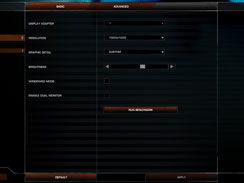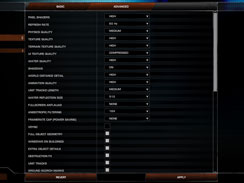Pre-OC Nvidia GeForce GTX 280 and 260
Written by Harry Butler
July 19, 2008 | 09:17
Tags: #260 #280 #amp #analysis #benchmarking #benchmarks #bfg #geforce #gtx #ocx #result #review #top

World in Conflict
Publisher: SierraWe regard World in Conflict as one of the best real-time strategy games we've ever played. It's based on Microsoft's DirectX 10 API and, in collaboration with Nvidia's The Way It's Meant To Be Played developer support team, it incorporates some DirectX 10 specific graphics effects.
The first of these is a soft particle effect that removes the banding often found in particle effects like smoke, explosions, fire and debris - the effects simply didn't exist in the 3D world; instead, they were merely an add-on. With DirectX 10, the edges of the particle effects are much softer and banding is almost non-existent as the effects now interact with their 3D surroundings, as they're actually a part of the 3D world.
Additionally there are global cloud shadowing and volumetric lighting effects in the DirectX 10 version of the game. The latter is often referred to as 'god rays' and its implementation in World in Conflict interacts with the surroundings incredibly well. On the other hand, the former is where clouds cast shadows on the rest of the environment and, because all clouds in World in Conflict are volumetric and dynamic, the shadows cast by the clouds are rendered dynamically in DirectX 10 - they adjust in relation to the size, shape and orientation of the cloud in relation to the light source.
For our testing purposes, we used a full retail copy of the game and patched it to version 1.007, which includes a few fixes and some improved performance under DirectX 10. We used a manual run through from the Invasion level, which incorporates all of the effects we've discussed above (and lots of artillery explosions!). We chose not to use the built-in benchmark because it's largely CPU-limited. We used the "very high" preset, and controlled Anti-Aliasing and Anisotropic Filtering via the advanced settings tab.
For our pre-overclocking tests, all GeForce cards were retested to ensure results were as accurate as possible.
World in Conflict
1680x1050, 4xAA, 16xAF, DX10, Very High Detail
- Asus GeForce GTX 280 TOP
- BFG GeForce GTX 280 OCX
- Zotac GeForce GTX 260 AMP!
- Nvidia GeForce GTX 280
- Nvidia Geforce 9800 GX2
- Nvidia GeForce GTX 260
- ATI Radeon HD 4870
- Nvidia GeForce 9800 GTX+
- ATI Radeon HD 3870 X2
- ATI Radeon HD 4850
-
-
38.2
-
28.0
-
-
-
36.5
-
27.0
-
-
-
36.4
-
29.0
-
-
-
36.1
-
28.0
-
-
-
34.4
-
22.0
-
-
-
33.5
-
23.0
-
-
-
30.5
-
20.0
-
-
-
28.7
-
19.0
-
-
-
28.5
-
22.0
-
-
-
24.2
-
17.0
-
0
10
20
30
40
Frames Per Second
-
Average
-
Minimum
World in Conflict
1920x1200, 0xAA, 16xAF, DX10, Very High Detail
- Asus GeForce GTX 280 TOP
- BFG GeForce GTX 280 OCX
- Nvidia GeForce GTX 280
- Zotac GeForce GTX 260 AMP!
- Nvidia GeForce GTX 260
- Nvidia GeForce 9800 GTX+
- Nvidia Geforce 9800 GX2
- ATI Radeon HD 3870 X2
- ATI Radeon HD 4850
- ATI Radeon HD 4870
-
-
37.2
-
28.0
-
-
-
35.9
-
28.0
-
-
-
35.7
-
28.0
-
-
-
35.4
-
27.0
-
-
-
34.2
-
25.0
-
-
-
33.9
-
21.0
-
-
-
33.6
-
16.0
-
-
-
31.2
-
23.0
-
-
-
31.0
-
23.0
-
-
-
30.9
-
23.0
-
0
10
20
30
40
Frames Per Second
-
Average
-
Minimum
World in Conflict
1920x1200, 2xAA, 16xAF, DX10, Very High Detail
- Asus GeForce GTX 280 TOP
- BFG GeForce GTX 280 OCX
- Nvidia GeForce GTX 280
- Zotac GeForce GTX 260 AMP!
- Nvidia Geforce 9800 GX2
- Nvidia GeForce GTX 260
- ATI Radeon HD 4870
- ATI Radeon HD 4850
- ATI Radeon HD 3870 X2
- Nvidia GeForce 9800 GTX+
-
-
36.6
-
29.0
-
-
-
36.3
-
28.0
-
-
-
36.1
-
28.0
-
-
-
33.7
-
27.0
-
-
-
33.1
-
15.0
-
-
-
32.8
-
23.0
-
-
-
29.7
-
22.0
-
-
-
29.6
-
23.0
-
-
-
29.2
-
22.0
-
-
-
29.2
-
16.0
-
0
10
20
30
40
Frames Per Second
-
Average
-
Minimum
World in Conflict
2560x1600, 0xAA, 16xAF, DX10, Very High Detail
- Asus GeForce GTX 280 TOP
- BFG GeForce GTX 280 OCX
- Nvidia GeForce GTX 280
- Zotac GeForce GTX 260 AMP!
- Nvidia Geforce 9800 GX2
- ATI Radeon HD 4870
- Nvidia GeForce GTX 260
- Nvidia GeForce 9800 GTX+
- ATI Radeon HD 4850
- ATI Radeon HD 3870 X2
-
-
35.8
-
31.0
-
-
-
34.3
-
23.0
-
-
-
33.5
-
24.0
-
-
-
33.1
-
26.0
-
-
-
31.0
-
9.0
-
-
-
29.5
-
22.0
-
-
-
29.3
-
22.0
-
-
-
26.3
-
18.0
-
-
-
25.3
-
17.0
-
-
-
24.6
-
18.0
-
0
10
20
30
40
Frames Per Second
-
Average
-
Minimum
World in Conflict
2560x1600, 2xAA, 16xAF, DX10, Very High Detail
- Asus GeForce GTX 280 TOP
- BFG GeForce GTX 280 OCX
- Nvidia GeForce GTX 280
- Zotac GeForce GTX 260 AMP!
- Nvidia GeForce GTX 260
- ATI Radeon HD 4870
- ATI Radeon HD 4850
- Nvidia GeForce 9800 GTX+
- ATI Radeon HD 3870 X2
- Nvidia Geforce 9800 GX2
-
-
32.5
-
25.0
-
-
-
32.0
-
25.0
-
-
-
30.9
-
24.0
-
-
-
27.7
-
21.0
-
-
-
25.0
-
20.0
-
-
-
24.1
-
17.0
-
-
-
19.7
-
12.0
-
-
-
18.0
-
11.0
-
-
-
15.8
-
9.0
-
-
-
6.6
- 3.0
-
0
5
10
15
20
25
30
35
Frames Per Second
-
Average
-
Minimum
As World in Conflict is such a CPU and GPU intensive game, the differences between cards in gameplay were minimal, with just five frames per second dividing all the stock and overclocked GT200 series GeForce cards at low resolution with 4xAA. As the resolutions increase, performance gaps become narrower and narrower, especially so when anti aliasing is disabled. Once again, the Zotac GTX 260 AMP! is able to beat the Radeon HD 4870 in every test, and it even flirts around the stock clocked GeForce GTX 280 in some circumstances, something that the stock GTX 260 was painfully unable to do. The Zotac GeForce GTX 260 AMP! is firmly in the top half of our results table in every test.











Want to comment? Please log in.